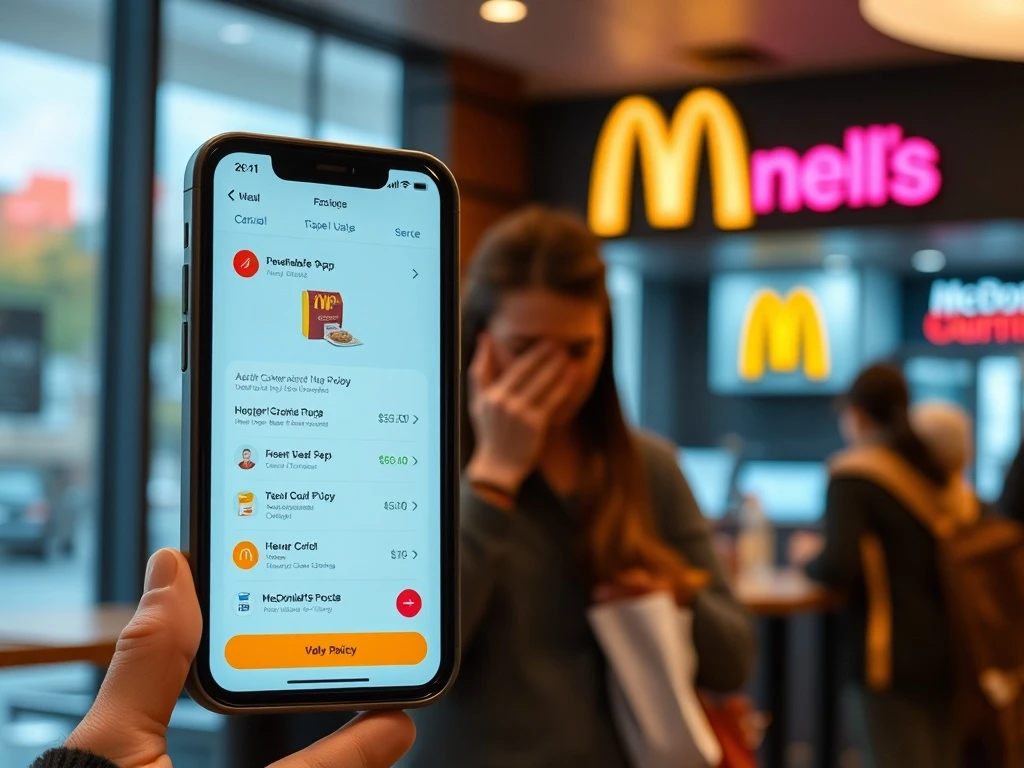McDonald’s, a global fast-food titan, faces a significant challenge. A recent policy change has stirred considerable controversy among its vast customer base. Many patrons express strong disapproval, feeling frustrated by the new mandate. This **McDonald’s new rule** aims to reshape customer interactions and streamline operations, but it also creates unexpected friction. Business leaders and entrepreneurs often analyze such corporate decisions. They observe how major brands balance innovation with customer satisfaction. Understanding the implications of this change is crucial for anyone interested in consumer behavior and market strategy.
Understanding the New McDonald’s Rule
So, what exactly is this contentious **McDonald’s new rule**? The company has introduced a policy mandating the use of its official mobile application for accessing loyalty points and exclusive discounts. Previously, customers could accumulate points through various methods, including traditional in-store or drive-thru purchases without digital interaction. Now, digital engagement is paramount for earning rewards. This shift pushes a significant portion of the customer base towards a digital-first approach. It represents a clear move away from purely transactional, in-person interactions. This new system means customers must download the app, create an account, and scan their digital loyalty code during every transaction to receive benefits. Consequently, those without smartphones or internet access face a significant barrier.
The core of this policy centers on enhancing the digital customer experience. McDonald’s aims to collect valuable data on purchasing habits. This data can then inform personalized marketing efforts. Furthermore, it seeks to increase app engagement and drive digital sales. The company believes this modernization will improve efficiency across its vast network of restaurants. This strategic pivot aligns with broader trends in the quick-service restaurant (QSR) industry. Many competitors are also investing heavily in digital platforms. However, McDonald’s unique position, serving a remarkably diverse demographic, makes this transition particularly impactful.
Customer Reaction: Why the McDonald’s New Rule Sparks Backlash
The immediate customer reaction to the **McDonald’s new rule** has been largely negative. Many loyal customers feel a sense of inconvenience and frustration. For instance, individuals who prefer traditional ordering methods find the digital requirement burdensome. This includes older demographics who may be less tech-savvy. They often lack smartphones or consistent internet access. Consequently, they feel excluded from the loyalty program they once enjoyed. This creates a significant digital divide. Such policies can alienate a segment of the customer base that values simplicity and direct service.
Moreover, privacy concerns frequently arise. Customers worry about the amount of personal data McDonald’s collects through the app. They question how this data is stored and utilized. The perception of being forced into a digital ecosystem can erode trust. Many customers simply want their food without the added steps of app navigation. The feeling of coercion often outweighs the perceived benefits of loyalty points. This negative sentiment spreads quickly through social media channels. Customers share their frustrations online, amplifying the backlash. This public outcry highlights the delicate balance companies must strike between technological advancement and customer comfort.
Here are key reasons for customer dissatisfaction:
- Inconvenience: The added step of opening an app and scanning a code slows down transactions for some.
- Digital Divide: Excludes customers without smartphones, data plans, or technological literacy.
- Privacy Concerns: Worries about data collection and its usage.
- Loss of Simplicity: Many prefer the straightforward, traditional ordering process.
- Feeling Forced: Customers dislike being compelled to adopt new behaviors to access existing benefits.
Business Implications of the McDonald’s New Rule
The implementation of this **McDonald’s new rule** carries significant business implications. In the short term, McDonald’s might see an increase in app downloads and digital transactions. This could provide valuable data for targeted marketing campaigns. Enhanced personalization might lead to higher average order values for app users. However, the potential for customer churn remains a major concern. Alienating a segment of the customer base could lead to reduced foot traffic and overall sales. This could negatively impact individual franchise profitability. The company must carefully monitor these trends to assess the true cost of the policy.
Long-term effects are also uncertain. While digital transformation is essential for modern businesses, the execution must be flawless. A poorly received policy can damage brand loyalty and public perception. McDonald’s has built its empire on accessibility and convenience for everyone. This new rule, however, introduces a barrier. Balancing the drive for efficiency and data with the risk of customer alienation is a complex strategic challenge. The success of this policy will depend on how effectively McDonald’s manages customer feedback. They must also provide robust support for those struggling with the transition. Furthermore, the company’s reputation as a family-friendly, universally accessible brand could suffer if the backlash persists.
Navigating the Digital Landscape: A Broader Trend
The **McDonald’s new rule** reflects a broader trend within the fast-food industry. Many chains are rapidly adopting digital strategies. Starbucks, for example, has successfully integrated its mobile app into its loyalty program. Their app-centric approach has driven significant engagement and sales. Similarly, Domino’s Pizza pioneered digital ordering, which contributed to its remarkable turnaround. These successes often encourage other companies to follow suit. The COVID-19 pandemic accelerated this shift, making digital ordering and contactless payments more common. Customers became accustomed to these conveniences.
However, McDonald’s serves a unique and incredibly diverse customer base. This includes individuals from all socioeconomic backgrounds and age groups. What works for a coffee chain with a generally younger, more tech-savvy demographic might not translate directly to a mass-market fast-food giant. The challenge for McDonald’s lies in adapting to digital trends without leaving a significant portion of its loyal customers behind. Therefore, while the move is strategically sound in a digitalizing world, its implementation requires careful consideration of its wide-ranging consumer base. Other chains are watching McDonald’s closely. They want to learn from its successes and its challenges.
Expert Perspectives on the McDonald’s New Rule
Industry analysts offer varied perspectives on the **McDonald’s new rule**. Many acknowledge the strategic necessity of digital transformation. They point out that collecting customer data is crucial for personalized marketing and operational efficiency. Furthermore, a strong app presence can drive repeat business and create a more seamless customer journey. One analyst stated, “In today’s competitive landscape, businesses must embrace digital channels to stay relevant. McDonald’s is simply adapting to consumer expectations for convenience and personalization.” This viewpoint emphasizes the long-term benefits of digital investment.
However, other experts warn about the risks of alienating a significant customer segment. They stress the importance of inclusivity in business strategies. “McDonald’s built its brand on universal accessibility,” commented another industry observer. “This policy risks undermining that core principle by creating a barrier for certain demographics.” These experts suggest that a more gradual or optional rollout might have been wiser. They emphasize the need for robust customer support during such transitions. Balancing technological advancement with customer satisfaction is a delicate act. Companies must listen to feedback and be prepared to adapt. The success of the **McDonald’s new rule** will ultimately depend on its ability to drive digital engagement without sacrificing overall customer loyalty.
The Path Forward: Adapting to Customer Feedback
The ongoing customer backlash presents McDonald’s with a critical juncture. To mitigate negative sentiment, the company might need to consider adaptations to its **McDonald’s new rule**. For instance, offering temporary in-store assistance for app usage could ease the transition for less tech-savvy customers. Providing clear, multilingual instructions on how to download and use the app would also be beneficial. Another potential solution involves a tiered loyalty system. This could allow a certain level of traditional point accumulation for those who prefer not to use the app. Such flexibility would demonstrate responsiveness to customer concerns.
Listening actively to customer feedback is paramount. McDonald’s could conduct surveys or establish dedicated channels for customer input regarding the new policy. This would allow them to identify specific pain points and develop targeted solutions. Ultimately, the long-term success of the **McDonald’s new rule** hinges on its ability to evolve. It must balance the company’s digital ambitions with the diverse needs and preferences of its vast customer base. Maintaining brand trust and loyalty remains a top priority. McDonald’s must prove that its digital transformation benefits all customers, not just a select few. The company’s reputation as a customer-centric brand is on the line.
Conclusion
The **McDonald’s new rule** represents a bold strategic move in the fast-food industry. It underscores the ongoing shift towards digital platforms and personalized customer experiences. While the policy aims to enhance efficiency and data collection, it has undeniably sparked significant customer backlash. The tension between technological innovation and customer satisfaction is evident. McDonald’s faces the challenge of modernizing its operations without alienating its loyal, diverse customer base. The success of this new rule will ultimately depend on the company’s ability to adapt. They must listen to feedback and ensure their digital future is inclusive. Only time will reveal the full impact of this controversial policy on McDonald’s brand and bottom line.
Frequently Asked Questions (FAQs)
What is the new McDonald’s rule regarding loyalty points?
The new **McDonald’s new rule** mandates that customers must use the official McDonald’s mobile application to earn and redeem loyalty points and access exclusive discounts. Traditional methods of earning points without app interaction are no longer supported for loyalty program participation.
Why did McDonald’s introduce this policy?
McDonald’s implemented this policy to drive digital engagement, collect valuable customer data for personalized marketing, and streamline operational efficiency. It aligns with the company’s broader digital transformation strategy to modernize its service and enhance the customer experience through technology.
How does this McDonald’s new rule affect customers?
This rule significantly affects customers by requiring smartphone and app usage for loyalty benefits. It can inconvenience those who prefer traditional ordering, lack digital access, or have privacy concerns. Some customers feel excluded from rewards they previously enjoyed easily.
Are there any alternatives to using the app for loyalty at McDonald’s?
Currently, the official **McDonald’s new rule** requires app usage for loyalty points and exclusive discounts. McDonald’s has not announced widespread alternatives for earning points outside the app. Customers may need to adapt to this digital requirement to benefit from the loyalty program.
What are the potential impacts on McDonald’s business?
The potential impacts include increased app downloads and digital sales, but also a risk of customer alienation and reduced foot traffic. It could affect brand loyalty and public perception, requiring McDonald’s to carefully balance innovation with customer satisfaction to maintain its broad appeal.
Is this McDonald’s new rule permanent?
Companies often review policies based on customer feedback and market performance. While the **McDonald’s new rule** is currently in effect as a strategic shift, its permanence or potential adjustments would depend on its success and how McDonald’s responds to ongoing customer sentiment and business outcomes.
























